Solutions for Electrical Contractors eTool
Supplemental Information » Tool Index
This index includes many general ergonomic principles that apply to this eTool and smart practices that increase productivity and decrease ergonomic risks.
- Aerial lifts
- Bent handles
- Digging tools
- Extension handles
- Foot pumps
- Forklifts
- Gloves
- Hydraulic tools
- In-line grip
- Kickback clutch
- Knee pads
- Ladders and stools
- Manual conduit benders
- Material lifts
- Mechanical conduit benders
- Mechanical wire pullers
- Motorized hand trucks
- Padded tool belts and suspenders
- Padded tool handles
- Pistol grip
- Portable pulley
- Powered tools
- Ratcheting tools
- Reach forklifts
- Roll-out truck bed decks
- Storage tools
- Tool handles
- Tool stands
- Transport devices
- Truck bins
- Truck ramps
- Vehicle lifts
- WAGO connectors
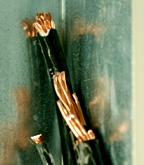

Aerial lifts provide a level work platform and allow employees to reach high places with ease, reducing the amount of overhead and horizontal reaching that is required. These lifts come in boom, reach, and scissor models.

Some tools may have a bend in the handle to accommodate performance of a task while maintaining a straight, neutral wrist posture. The nature and degree of the bend is dependent upon the task being performed.
In Figure 1, the left panel shows a 45 degree bend in the tool so the wrist can be maintained in a neutral posture. In right panel, the handle is straight and the wrist must be bent. In Figure 2, the pliers handle is bent to minimize the wrist bending when working on a vertical work surface.

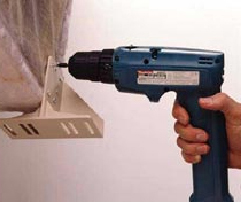
Use of Pistol grip tools (Figure 3) maintains a neutral wrist posture when working on vertical surface at about waist height or when working on a horizontal work below waist height.
There are different shovels and spades for different jobs, including square-blade, round-nose, triangular, and trenching/hole-digging shovels. Use the right tool, with a handle in good repair, without splinters.
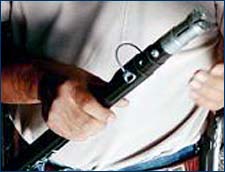
Extension handles reduce the amount of reaching required to do certain tasks. This reduces back and shoulder strain.
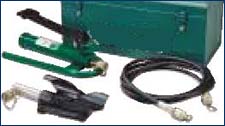
This hydraulic foot pump allows the operator to use foot power and free the hands to hold the work piece.
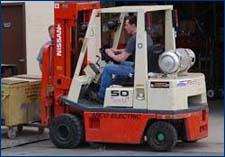
In a warehouse setting, a forklift is essential for lifting large loads that have not been broken down.

Gloves should be fitted to the user. A glove that is too small restricts opening of the hand requiring increased finger force. A glove that is too large, can create bulkiness that restricts closing of the hand increasing the finger force required to perform a task.
Gloves can be slick and reduce the tactile feel both of which force employees to exert more finger force to achieve a feeling of control when using tools. The addition of rubberized or sticky nubs or coatings will improve the grip and increase control when using gloves
However, gloves are important to protect the hand from cold, cuts, punctures and possible chemical agents. Gloves with padded palms and fingers can also protect against contact stress from tools and work surfaces.
There are a variety of gloves for different situations. There are lined gloves, unlined gloves, gloves with no cuff, medium cuff and long cuff. Cut-resistant Kevlar® gloves (pictured) provide extra protection against cuts and scratches. [Note: OSHA does not register, certify, approve, or otherwise endorse commercial or private sector entities, products, or services.]

Hydraulic tools reduce the hand power needed for cutting, wire-stripping, and crimping operations. This tool uses a remote hydraulic pump so only the tool needs to be lifted, instead of the whole pump mechanism as well.
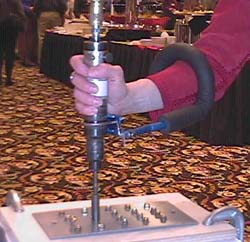
Some tools are designed with handles that run the same direction as the length of the tool. This design is appropriate when working at about waist height on a horizontal work surface or above shoulder height on a vertical work surface.
Tools equipped with a kickback clutch are safer and reduce the risk of having a tool jump or move unpredictably.
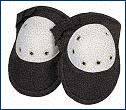
When kneeling is required, knee pads ease the stress on knees and allow employees to kneel for longer periods of time.

Ladders and stools allow employees to get closer to their work and keep hands and arms closer to the body. This reduces strain placed on the arms, shoulders, and back.
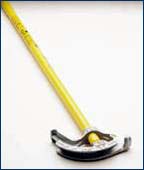
Manual conduit benders are lighter, less expensive and more portable than mechanical conduit benders. They are useful for smaller gauges of conduit.
These benders should be fitted with long, rigid handles without scratches or dents. Use manual conduit benders correctly and let the tool do the work instead of the back.

Material lifts serve the same function as forklifts, but they are more portable and can be taken to the work site. Manual and powered models are available.

Mechanical conduit benders make bending conduit easy, especially for large diameter material. The machine does the work, so employees don't have to bend conduit manually. They are often mounted on wheels so they can be rolled to different locations.
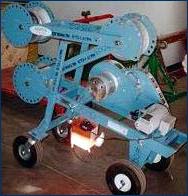
Mechanical wire pullers do the work of pulling, reducing the strain that would occur from doing this manually. They also save time and increase productivity.

These special hand trucks climb stairs, lift onto tailgates, and make moving easy. The initial investment pays off in time saved and injury costs avoided.

Padded tool belts reduce potential contact stress by evenly distributing the weight that tool belts and bags place on hips. Suspenders ease the burden of tool belts and bags by distributing some of the weight to the shoulders.

Tools like this crimping/cutting tool are fitted with padded handles that ease the stress placed on hands by spreading the force over a wider area. They provide a good grip, which reduces slipping.
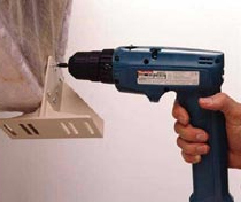
Many tools are designed with a pistol-style grip. This design is appropriate for work on a vertical work surface at about waist to chest height or when working on a horizontal surface at mid thigh or lower. Can also be used when working on a horizontal surface directly over head.

The pulley wheel is temporarily suspended from the ceiling. The cables to be pulled run over the top of the wheel, allowing the employee to pull while standing on the floor and working in a neutral posture. Another pulley positioned at the end of the process allows the other employee to feed the cables while in a similar posture.

Powered tools, like this battery-powered cable cutter, speed up tasks and reduce the strain that occurs from using a comparable hand-powered tool. This is especially helpful when employees must do many cutting or crimping operations over a short span of time. Battery-powered tools are usually lighter and more portable than hydraulic tools.

Tools like this PVC cutter are equipped with a ratcheting mechanism. This allows an easier, incremental squeezing effort to operate the tool, easing strain on hands and wrists.
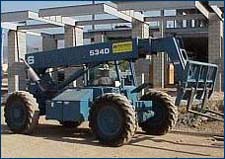
Reach forklifts can lift materials to great heights, and place large loads into trucks or on platforms.
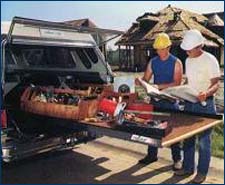
Roll-out truck bed decks bring the material to the employee and provide easy access to the contents of a truck bed. This eliminates the need to climb in a cramped truck bed area or reach over the sides of the truck.
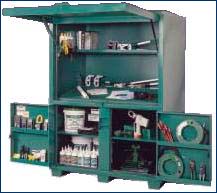
Storage units like this one allow easy access to tools and supplies. Some are mobile and can be placed close to the work area, reducing the distance tools and supplies must be carried.
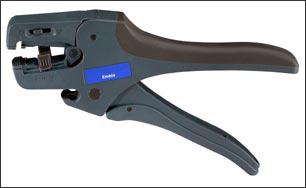
The tool handle should be about four to five inches (Figure 6) in length so that it fully extends across the palm of the hand. The screwdriver or hammer-like handle should have a diameter of about 1.5 inches.

A dual-handle tool, such as pliers, should have a span of 2 1/2 to 3 1/2 inches. This should allow most employees to maintain a "C-shape" hand posture (Figure 7) while gripping the tool.
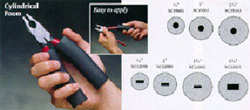
Tools should have slip-resistant surface to improve control and grip. Handles should be rounded handles so that no sharp edges come in contact with the hand (Figure 8). Handles may be padded to spread the force over a wider area. Generally, a screwdriver-type handle with a triangular shape provides more efficient exertion of force.
The handle should be appropriately modified to the task being performed to minimize wrist bending. The wrist should remain as straight as possible while using the tool.
-
Ergonomic Design for People at Work, Volume 2. Eastman Kodak Company, (1986).
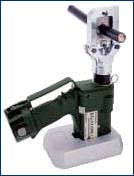
This battery-powered cable cutter rests in a stand that frees hands and improves the cutting process. This stand may remain unattached or it may be fastened to a work bench.

Transport devices, like this spool cart, make moving smaller loads easy. Other moving tools include hand trucks, utility carts, and platform trucks.
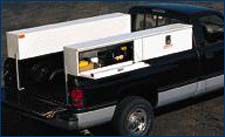
Truck bins give easy access to equipment without the need to crawl into the back of a truck or van.

Truck ramps are essential when moving large tools such as a cable puller or powered conduit benders. They reduce the amount of lifting required to move heavy items into the back of a truck. Materials may instead be wheeled or pushed.
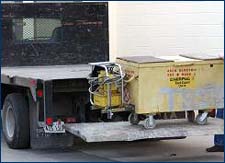
Vehicle lifts allow heavy loads such as a mechanical cable puller or conduit benders to be moved in and out of trucks and vans with ease, requiring less manual lifting to unload vehicles.

Wire is pushed into the holes of these connectors and require no tools. This saves time and reduces wrist strain.

